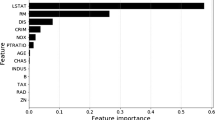Abstract
In this paper, we develop a dynamic partially functional linear regression model in which the functional dependent variable is explained by the first order lagged functional observation and a finite number of real-valued variables. The bivariate slope function is estimated by bivariate tensor-product B-splines. Under some regularity conditions, the large sample properties of the proposed estimators are established. We investigate the finite sample performance of the proposed methods via Monte Carlo simulation studies, and illustrate its usefulness by the analysis of the electricity consumption data.


Similar content being viewed by others
References
Aneiros G, Bongiorno EG, Cao R, Vieu P (2017) Functional statistics and related fields. Springer, Berlin
Aneiros G, Vieu P (2008) Nonparametric time series prediction: a semi-functional partial linear modeling. J Multivar Anal 99:834–857
Bosq D (2000) Linear processes in function spaces. Springer, Berlin
Fan ZH, Reimherr M (2017) High-dimensional adaptive function-on-scalar regression. Econom Stat 1:167–183
He X, Shi P (1994) Convergence rate of B-spline estimators of nonparametric conditional quantile functions. J Nonparametr Stat 3:299–308
He X, Fung WK, Zhu Z (2005) Robust estimation in generalized partial linear models for clustered data. J Am Stat Assoc 100(472):1176–1184
Hörmann S, Horváth L, Reeder R (2013) A functional version of the ARCH model. Econometr Theory 29(2):267–288
Kokoszka P, Miao H, Reimherr M, Taoufik B (2017) Dynamic functional regression with application to the cross-section of returns. J Financ Econometr 16:1–25
Ramsay JO, Silverman BW (2005) Functional data analysis, 2nd edn. Springer, New York
Reimherr M, Dan N (2014) A functional data analysis approach for genetic association studies. Ann Appl Stat 8(1):406–429
Schumaker LL (1981) Spline functions: basic theory. Wiley, New York
Acknowledgements
Du’s work is supported by the National Natural Science Foundation of China (Nos. 11771032), the Science and Technology Project of Beijing Municipal Education Commission (KM201910005015), Young Talent program of Beijing Municipal Commission of Education (No. CIT&TCD201904021), and the International Research Cooperation Seed Fund of Beijing University of Technology (No. 006000514118553). Zhangs work is supported by the National Natural Science Foundation of China (No. 11271039).
Author information
Authors and Affiliations
Corresponding author
Additional information
Publisher's Note
Springer Nature remains neutral with regard to jurisdictional claims in published maps and institutional affiliations.
Appendix. Proofs
Appendix. Proofs
The following lemma, which follows easily from Theorem 12.7 of Schumaker (1981), is stated for ease of reference.
Lemma 1
Under Assumption 1, there exists a spline function
which is called spline approximation of \(\beta (t,s)\), such that
where \({\varvec{\alpha }}=(\alpha _{1,1},\alpha _{1,2},\ldots ,\alpha _{1,M_N},\alpha _{2,1},\ldots ,\alpha _{2,M_N},\alpha _{3,1},\ldots ,\alpha _{M_N,M_N})^T.\)
Proof of Theorem 1
By Lemma 1, there exists \({\varvec{\alpha }}\) such that
uniformly in \((t,s)\in [0,1]\times [0,1]\). Then, it has
where \({\varvec{\eta }}^*(t)=\left( \int _0^1Y_1(s)\beta ^*(t,s)ds,\ldots ,\int _0^1Y_{N-1}(s)\beta ^*(t,s)ds\right) ^T.\) By the definition of \({\varvec{\eta }}^*(t)\), one has
where
and
Invoking the definition of \({\varvec{P}}_N\), it is easy to show that \(({\varvec{I}}_N-{\varvec{P}}_N)\widetilde{{\varvec{Z}}}=0.\) Thus, we have
where
and
Invoking the properties of B-spline and Assumption 1, we can get \(\Vert {\varvec{II}}_2\Vert =O_p\left( NM_N^{-r-1}\right) \) and \(\Vert {\varvec{I}}_1\Vert =O_p\left( \sqrt{N}M_N^{-1}\right) \) via routine calculation.
First, consider \({\varvec{A}}_1\). By the law of large numbers and Assumptions 1 and 3, one has
where \(K_Z(t,s)=E[(Y_n(t)-E(Y_n(t)|Z_n))(Y_{n-1}(s)-E(Y_{n-1}(s)|Z_{n-1}))]\). Combining \({\varvec{I}}_1, {\varvec{II}}_2\) with the properties of B-spline, one has \(\Vert \hat{ {\varvec{\alpha }}}- { {\varvec{\alpha }}}\Vert =O_p(M_N^{-r+1})+O_p(M_NN^{-1/2}).\) By triangle inequality and Lemma 1, we have
\(\square \)
Proof of Theorem 2
By the proof of Theorem 1, we have
where
and
First, consider \(R_1(t,s).\) By the central limit theorem and Assumption 2, one has \(R_1(t,s){\mathop {\longrightarrow }\limits ^{L}}{\varvec{G}}(t,s),\) where \({\varvec{G}}(t,s)\) is a normal distribution with zero mean and the covariance
with
where \(C_\varepsilon (t,s)=\text {Cov}(\varepsilon _n(t),\varepsilon _n(s)).\)
Next, consider \(R_2(t,s).\) Invoking Theorem 1 and \(N/M_N^{2r+2}=o(1)\), we have
Combining the asymptotic normality of \(R_1(t,s)\) with the convergence rate of \(R_2(t,s)\), one has
This completes the proof. \(\square \)
Proof of Theorem 3
Invoking \(\widetilde{{\varvec{Y}}}(t)={\varvec{\eta }}_{\beta }(t)+\widetilde{{\varvec{Z}}}{\varvec{\theta }}(t)+{\varvec{\varepsilon }}(t)\), one has
where \(R_1(t)=\sqrt{N}(\widetilde{{\varvec{Z}}}^T \widetilde{{\varvec{Z}}})^{-1}\widetilde{{\varvec{Z}}}^T[{\varvec{\eta }}_{\beta }(t)-{\varvec{\hat{{\varvec{\eta }}}}}_{\hat{\beta }}(t)]\) and \(R_2(t)=\sqrt{N}(\widetilde{{\varvec{Z}}}^T \widetilde{{\varvec{Z}}})^{-1}\widetilde{{\varvec{Z}}}^T{\varvec{\varepsilon }}(t)\).
First, consider \(R_1(t)\). By Assumption 1 and Theorem 1, we have \(\Vert {\varvec{\eta }}_{\beta }(t)-{\varvec{\hat{{\varvec{\eta }}}}}_{\hat{\beta }}(t)\Vert =O_p(NM_N^{-r}).\) Consequently, it has
Next, consider \(R_2(t)\). By the CLT for Hilbert spaces, we have \(\frac{1}{\sqrt{N}}\sum _{n=1}^N {\varvec{Z}}_n \varepsilon _n(t) {\mathop {\longrightarrow }\limits ^{L}}{\varvec{B}}_1(t),\) where \({\varvec{B}}_1(t)\) is a Guassian processes with zero mean and the covariance function \(C(t, s) = \text {Cov}(\varepsilon _n(t),\varepsilon _n(s))\). Denote \({\varvec{\Sigma }}=\text {E}[{\varvec{Z}}{\varvec{Z}}^T].\) By the strong law of large numbers and the CLT for Hilbert spaces, it has
Combining this with \(\Vert R_1\Vert =o_p(1),\) one has \(\sqrt{N}[{\varvec{\hat{\theta }}}(t)-{\varvec{\theta }}(t)] \longrightarrow {\varvec{G}}(t),\) where \({\varvec{G}}(t)\) is a Guassian processes with zero mean and the covariance function \(C_{{\varvec{B}}}(t, s) = {\varvec{\Sigma }}^{-1} \text {Cov}(\varepsilon _n(t),\varepsilon _n(s))\). \(\square \)
Rights and permissions
About this article
Cite this article
Du, J., Zhao, H. & Zhang, Z. Dynamic partially functional linear regression model. Stat Methods Appl 28, 679–693 (2019). https://doi.org/10.1007/s10260-019-00457-x
Accepted:
Published:
Issue Date:
DOI: https://doi.org/10.1007/s10260-019-00457-x
Keywords
- Functional time series
- Bivariate tensor-product B-splines
- Functional data analysis
- Autoregressive Hilbertian process




